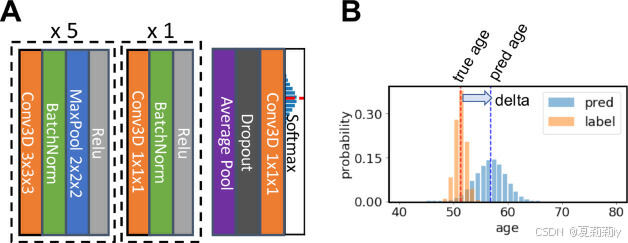
论文网址:Accurate brain age prediction with lightweight deep neural networks - ScienceDirect
英文是纯手打的!论文原文的summarizing and paraphrasing。可能会出现难以避免的拼写错误和语法错误,若有发现欢迎评论指正!文章偏向于笔记,谨慎食用
目录
2.3.1. Model: Simple Fully Convolutional Network (SFCN)
2.3.2. Regression models: Elastic Net
2.4.1. Datasets and preprocessing
2.5.1. The performance of SFCN in UK Biobank data
2.5.2. The performance of SFCN in UK Biobank data
1. 心得
(1)不是我又想看老古董可能是新的没search到我想要的...这叫...重回经典...
(2)啊,是2019 Predictive Analysis Challenge竞赛论文
(3)典型的2021的CNN,要多典有多典
2. 论文逐段精读
2.1. Abstract
①They proposed Simple Fully Convolutional Network (SFCN) to predict brain age by T1 image, aiming to solve problems of limit data and computing cost(刚想说为什么预测年龄不用fmri,毕竟很care功能,突然看到是竞赛的那没事了应该是固定数据集的,投期刊也最多小扩一下也不会大改)
2.2. Introduction
①⭐The difference between physiological age and brain age is actually, useful and interesting
②They use positive delta to represent the brain age of a subject is elder than his/her physiological age
③Such a brain-age delta can be regarded as a biomarker or used for predicting mortality
2.3. Methods
2.3.1. Model: Simple Fully Convolutional Network (SFCN)
①Overall framework of SFCN:

②Input shape: 160*192*160 with 1mm each resolution
③Channel in each conv: [32, 64, 128, 256, 256, 64, 40] (orange~block~)
④Output: 42-82 (one-year age interval) vector for UK Biobank and 14-94 (two-year age interval ) vector for PAC 2019:
where denotes the probability of predicting age at
,
is bin centre for the age interval
假设预测的年龄区间是42到82岁,并且有40个年龄区间,每个区间代表一个一岁的年龄段。每个年龄区间都有一个对应的概率,表示该区间包含受试者真实年龄的可能性。年龄区间的中心(
)就是该区间的中点。
例如,假设有以下几个年龄区间和概率:
对于区间[42, 43), = 42,模型可能预测出该区间的概率为 = 0.1(即10%的可能性)。
对于区间[43, 44), = 43,模型可能预测出该区间的概率为 = 0.2(即20%的可能性)。
对于区间[44, 45), = 44,模型可能预测出该区间的概率为 = 0.3(即30%的可能性)。
这些概率和年龄值会被用来加权计算受试者的最终预测年龄:
⑤Parameters comparison:
| SFCN | 3.0 million parameters |
| 3D ResNet-18 | 33.2 million |
| 3D ResNet50 | 46.2 million |
| 2D VGGnet | 133 million |
2.3.2. Regression models: Elastic Net
①3 forms of data in UKB:
| 1 | raw T1 |
| 2 | Voxel-level grey matter partial-volume estimated by FSLVBM voxel-based morphometry |
| 3 | T1-image derived region-level phenotypes |
they reduce dimensionality to 5000 by PCA on (1) and (2), nothing for (3)
2.3.3. Bias correction
①Bias correction: linear bias correction method
②The corrected predicted age:
2.4. Experiments
2.4.1. Datasets and preprocessing
(1)UK Biobank
①Subjects: 14,503
②Data split: 12,949 for tr, 518 for val, 1,036 for test
③Preprocessing: already preprocessed data
(2)PAC 2019
①Competition entries: a) lowest MAE score, b) low Spearman correlation between brain age and real age
②Subjects: 2,638
③Data split: 2,199 for tr, 439 for val, 660 for test
2.4.2. Training and testing
①Optimizer: Stochastic Gradient Descent (SGD) optimiser
②Loss: Kullback–Leibler divergence
③Data augmentation: for input, a) randomly shifted by 0, 1 or 2 voxels along every axis; b) has a probability of 50% to be mirrored about the sagittal plane.
④L2 weight decay coefficient: 0.001
⑤Batch size: 8
⑥Learning rate: 0.01, multiplied by 0.3 every 30 epochs
⑦Epoch: max 130
2.4.3. Sex classification
①Loss: CE
2.5. Results
2.5.1. The performance of SFCN in UK Biobank data
①Performance on UKB:

②Performance of SFCN with different regularisation and data augmentation methods:

③Performance on UK Biobank:

④Sex classification performance on UK Biobank:

2.5.2. The performance of SFCN in UK Biobank data
①Learning curve:

2.5.3. Semi-multimodal model ensemble improves the performance with limited number of training subjects
①Performance on different modality:

②Correlation between modalities and models:

⭐for B, the lower the correlation between models, the better they fuse to ensemble and predict
2.5.4. Bias correction
①Bias correction:

where the left one is real distribution, middle is results of delta without correction, right is after correction
②Performance w/o correction:

2.6. Conclusion
作者抛出的2021年的可解释性或者黑盒的问题到2025年其实还是没有很好地解决
3. Reference
Peng, H. et al. (2021) Accurate brain age prediction with lightweight deep neural networks, Medical Image Analysis, 68. doi: Redirecting

























 被折叠的 条评论
为什么被折叠?
被折叠的 条评论
为什么被折叠?








